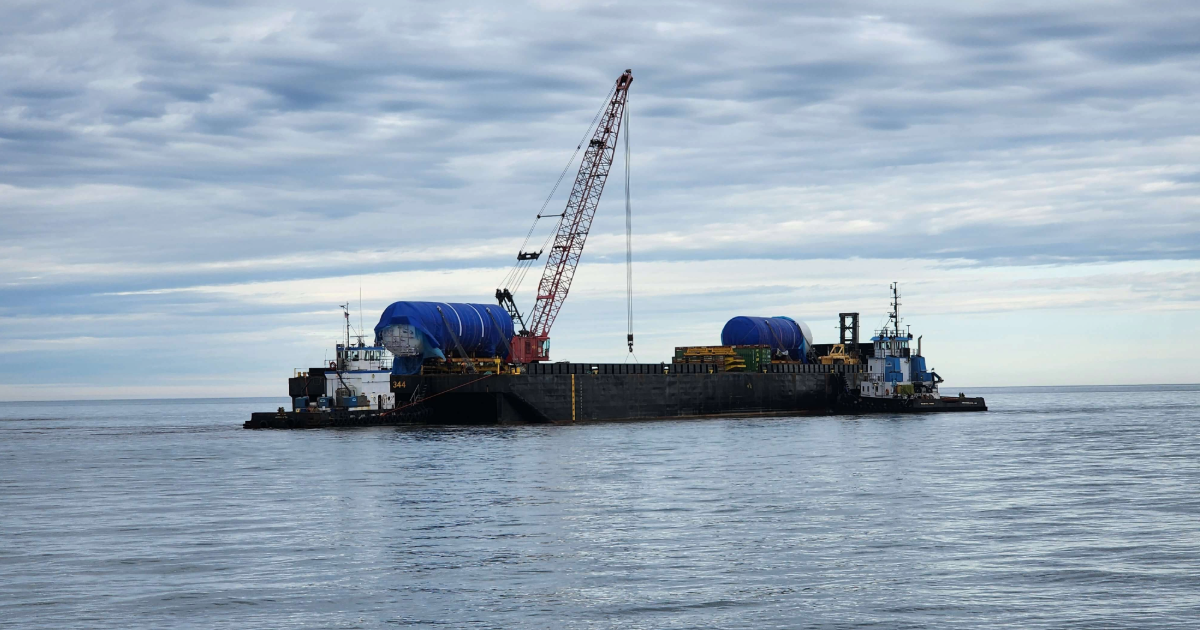 LNG tanks arrive at Prudhoe Bay’s West Dock after a month-long multi-modal journey from India.
LNG tanks arrive at Prudhoe Bay’s West Dock after a month-long multi-modal journey from India.
“We are helping to change the face of Alaska through this transportation contribution,” says Lynden Logistics International Operations Manager Brandie Holmes. Holmes and the Lynden team recently coordinated the move of two huge Liquified Natural Gas (LNG) storage tanks from Mumbai, India to Prudhoe Bay for the construction of a natural gas treatment, liquefication and truck loading facility near Deadhorse, AK. Harvest Midstream and Interior Gas Utility (IGU) plan to use North Slope natural gas to produce LNG that will ultimately be trucked 500 miles to Fairbanks to deliver a reliable source of energy to IGU customers there.
“We are investing in a project that uses North Slope gas already being produced to bring reliable and long-term energy to the interior of Alaska,” says Harvest CEO Jason Rebrook. It’s estimated that 150,000 gallons of LNG could be produced at the facility each day.
Lynden’s involvement with this groundbreaking project began earlier this year when a current customer, Mac Rail, contacted Holmes. “A strong relationship has developed with Mac and his company, Hilcorp, over the past few years I’ve been on the team,” Holmes explains. “Mac supports logistics for Harvest Midstream, a sister company to Hilcorp, and inquired if a move of this magnitude was in Lynden’s wheelhouse. Hilcorp has been impressed with our ability to handle oversized moves and support their international shipping needs. With our experience and knowledge of Alaska, and our strong overseas partners, they knew we could take on an international move from India to Prudhoe Bay, so we kicked off the proposal process.”
Putting together the logistics plan began with imagining what the collection and transportation of the tanks in India to the port of departure in Mundra would look like. “It required working closely with our overseas partner in the area, Logistics Integrated and its General Manager Rupesh Khanvilkar. He was a very important element to our operations at origin,” she explains.
Import and export documentation was prepared, marine and surface moves began to take shape, route surveys were performed and approved, and ocean routing to the U.S. secured. One of the early challenges was learning that the tanks were almost double the weight originally stated in the initial discussions, and knowing that the delivery location of Prudhoe Bay, AK is only serviced once yearly via ocean barge.
Acquiring equipment and vessels to accommodate the 200,000-pound, 64-feet by 18-feet tanks between Tacoma and Alaska simply involved a phone call to Alaska Marine Lines’ Director of Marine Operations Brian Ward and Pricing Logistics Analyst Rick Kellogg. Lynden Logistics teamed with sister company Alaska Marine Lines for the transit north to Alaska from the Lower 48 using the company’s Arctic voyage.
The Lynden team designed a three-part multimodal plan: 1) Truck transport 270 miles through India from Hazira, Surat, to the Port of Mundra; 2) A 10,000-nautical-mile voyage to the Port of Tacoma; and 3) Sailing 2,000 more nautical miles from Seattle to Prudhoe for final delivery.
 Transloading tanks at the Port of Tacoma.
Transloading tanks at the Port of Tacoma.
“Arranging pickup of the tanks at origin, trucking these beasts to the port and lining up the vessel to bring them to Tacoma was really challenging with so many moving parts,” Holmes says. “Timing was critical to make sure we had little to zero waiting time at the port. Then we had the vessel as a partial charter on its own schedule. We also had to calculate arrival to the Port of Tacoma and docking so delivery of the tanks could be made to Alaska Marine Lines’ barges for loading in advance of the Arctic voyage.”
After a six-week ocean voyage from India, the MV Janis arrived at the Port of Tacoma. “Once the units arrived at the Port of Tacoma and other goods offloaded, the vessel unlashed from the dock and turned completely around so our barge could be tugged over alongside and tied off to it. This allowed her starboard side cranes to unload the tanks over the railing, water side, directly to the barge,” Ward says. “The vessel has two onboard cranes with more than enough capacity to lift the tanks out of her hold to the barge.” Alaska Marine Lines Riggers Jonathan Satre and Travis Tinney were on deck during the transload to supervise. Spreader bars, a cradle and other rigging equipment came into play as the experienced mariners set about getting the tanks from one vessel to the other. The tanks are now enroute on an Alaska Marine Lines’ sailing which travels north along the entire coast of Alaska, past Barrow, to destination at Prudhoe Bay.
.jpg?width=2040&height=1536&name=1000001258%20(1).jpg) Alaska Marine Lines employees at the Port of Tacoma transload.
Alaska Marine Lines employees at the Port of Tacoma transload.
Moving huge pieces of equipment from one point on the globe to another is sheer delight for Holmes. “We are rock stars at Lynden, we love what we do… and we have fun!” she says. “I’ve been doing transportation into and out of Alaska and internationally for 25 years. With projects like this, you learn that you can’t do it alone. It’s a team effort, and one we are well suited for with our Lynden group of multimodal specialists. Lynden was the perfect match for this move, which has been one of the most interesting I‘ve done with the water-to-water transload, narrow sailing window, and the opportunity to play a part in upgrading energy options in the Fairbanks community. I like to say I can touch the world from here – working on projects with global impact.”
Topics from this blog: Lynden Alaska Lynden Logistics Energy Charters Project Logistics Multi-Modal Ocean International AML Featured

